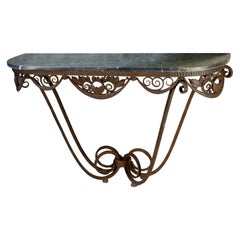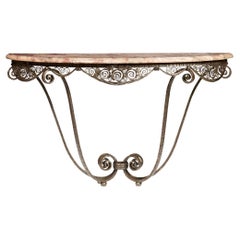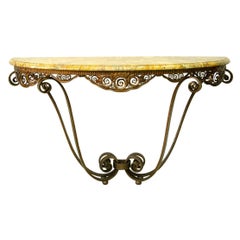Edgar Brandt Simplicite
Vintage 1920s French Art Deco Console Tables
Marble, Iron
Recent Sales
Vintage 1920s French Art Deco Console Tables
Marble, Steel
Vintage 1920s French Art Deco Drawings
Marble, Iron
People Also Browsed
21st Century and Contemporary Italian Mid-Century Modern Wall Mirrors
Brass
Vintage 1950s Italian Mid-Century Modern Sofas
Fabric, Wood
21st Century and Contemporary Portuguese Mid-Century Modern Coffee and C...
Marble, Carrara Marble, Onyx, Travertine, Gold Leaf
20th Century German Art Nouveau Animal Sculptures
Bronze
Vintage 1920s French Art Deco Console Tables
Marble, Wrought Iron
2010s South African Modern Dining Room Chairs
Ceramic, Upholstery, Walnut
Vintage 1930s French Art Deco Wall Mirrors
Wrought Iron
2010s South African Modern Daybeds
Steel
Antique 19th Century French Empire Console Tables
Carrara Marble
Antique 1890s Swedish Art Nouveau Chandeliers and Pendants
Bronze
Early 20th Century French Art Deco Chandeliers and Pendants
Wrought Iron
Vintage 1930s French Art Deco Side Tables
Mahogany
Early 20th Century Persian American Craftsman Persian Rugs
Wool
21st Century and Contemporary French Mid-Century Modern Armchairs
Mohair, Wood
Early 20th Century French Art Nouveau End Tables
Mahogany
Mid-20th Century French Art Deco Chandeliers and Pendants
Wrought Iron
Edgar Brandt for sale on 1stDibs
French metalworker Edgar Brandt refused to settle into a single way of doing things and he constantly experimented with different techniques, mediums and styles. From his earliest dive into Art Nouveau to his transition to Art Deco, Brandt brought his craft to bear on pieces ranging from architectural elements, such as doors, to furnishings like console tables and wall sconces — each object rich with thoughtful detail.
When he was 13, Brandt was enrolled by his parents in the prestigious École Nationale Professionnelle de Vierzon boarding and trade school. The school placed him in the ironworking program, where he learned traditional forging methods. He served two years in the military after graduating and subsequently opened a small shop to practice his craft.
In his cozy atelier in Paris, Brandt designed small metal objects like crosses, rings and pendants. He methodically created each piece and slowly worked his way up to larger projects. Inspired by the Art Nouveau furnishings of Louis Majorelle, fashioned from wood and wrought iron, Brandt added furniture design to his skillset.
In 1914, the French military called on Brandt to serve in World War I. During this time, he designed weapons and shell casings that were widely copied and used in both world wars.
After peace temporarily took shape in Europe, Brandt worked tirelessly to design and produce a wide variety of metal pieces. Every year, he showed his work at the Salon d’Automne. In 1919, he expanded his enterprise by building a new workshop, where he employed 100-plus workers. International demand for his work prompted Brandt to expand further and open a factory in the Parisian suburb of Chatillon-sous-Bagneux. There, he had more than 3,000 employees.
In 1936, the French government nationalized his company, and they began to produce armaments under Brandt's name. The onset of World War II led Brandt and his family to flee to Switzerland, where they stayed until the fighting was over. When he finally returned to France, Brandt didn’t reopen his studio. He chose, instead, to work on small-scale projects until his death in 1960.
Brandt received many high-profile commissions and participated in several important collaborations. He co-created some of France's most notable monuments, including the French Tomb of the Unknown Soldier at the Arc de Triomphe — completed in 1921. He received the title Knight of the Legion of Honor and the Medal of Honor for Applied Art from the French Society of Artists.
On 1stDibs, find antique Edgar Brandt lighting, tables and decorative objects.
A Close Look at Art-deco Furniture
Art Deco furniture is characterized by its celebration of modern life. More than its emphasis on natural wood grains and focus on traditional craftsmanship, vintage Art Deco dining chairs, tables, desks, cabinets and other furniture — which typically refers to pieces produced during the 1920s and 1930s — is an ode to the glamour of the “Roaring Twenties.”
ORIGINS OF ART DECO FURNITURE DESIGN
- Emerged in the 1920s
- Flourished while the popularity of Art Nouveau declined
- Term derives from 1925’s Exposition Internationale des Arts Décoratifs et Industriels Modernes (International Exhibition of Modern Decorative and Industrial Arts) in Paris, France
- Informed by Ancient Egypt, Cubism, Futurism, Louis XVI, De Stijl, modernism and the Vienna Secession; influenced Streamline Moderne and mid-century modernism
CHARACTERISTICS OF ART DECO FURNITURE DESIGN
- Bold geometric lines and forms, floral motifs
- Use of expensive materials such as shagreen or marble as well as exotic woods such as mahogany, ebony and zebra wood
- Metal accents, shimmering mirrored finishes
- Embellishments made from exotic animal hides, inlays of mother-of-pearl or ivory
ART DECO FURNITURE DESIGNERS TO KNOW
VINTAGE ART DECO FURNITURE ON 1STDIBS
Few design styles are as universally recognized and appreciated as Art Deco. The term alone conjures visions of the Roaring Twenties, Machine Age metropolises, vast ocean liners, sleek typography and Prohibition-era hedonism. The iconic movement made an indelible mark on all fields of design throughout the 1920s and ’30s, celebrating society’s growing industrialization with refined elegance and stunning craftsmanship.
Widely known designers associated with the Art Deco style include Émile-Jacques Ruhlmann, Eileen Gray, Maurice Dufrêne, Paul Follot and Jules Leleu.
The term Art Deco derives from the name of a large decorative arts exhibition held in Paris in 1925. “Art Deco design” is often used broadly, to describe the work of creators in associated or ancillary styles. This is particularly true of American Art Deco, which is also called Streamline Moderne or Machine Age design. (Streamline Moderne, sometimes known as Art Moderne, was a phenomenon largely of the 1930s, post–Art Nouveau.)
Art Deco textile designers employed dazzling floral motifs and vivid colors, and while Art Deco furniture makers respected the dark woods and modern metals with which they worked, they frequently incorporated decorative embellishments such as exotic animal hides as well as veneers in their seating, case pieces, living room sets and bedroom furniture.
From mother-of-pearl inlaid vitrines to chrome aviator chairs, bold and inventive works in the Art Deco style include chaise longues (also known as chaise lounges) and curved armchairs. Today, the style is still favored by interior designers looking to infuse a home with an air of luxury and sophistication.
The vintage Art Deco furniture for sale on 1stDibs includes dressers, coffee tables, decorative objects and more.


